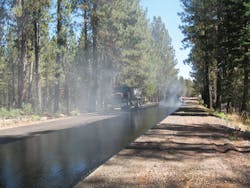One type of seal coat is hot-applied chip seal, which includes placing a spray of hot asphalt binder followed by a layer of crushed stone. The aggregates are then rolled and embedded into the binder. The chip seals seal the existing pavement surface, extend its service life and provide a solid wearing course with good skid resistance.
In California, the asphalt rubber binder used in chip seals has typically been a field-blended asphalt rubber binder (Type II) which consists of asphalt binder, asphalt modifier and crumb rubber modifier (CRM) including scrap tire crumb rubber and high natural crumb rubber. Another field-blended asphalt rubber binder (Type I) that has found use in Arizona, Florida and Texas does not require asphalt modifier and high natural crumb rubber. Caltrans decided to look into its potential application in California.
Piloting the spec
Crumb rubber R18 modified binder (CRR18MB), which contains a minimum 18% crumb rubber and is blended at a refinery terminal, is a relatively new hot-applied asphalt binder for chip seals. This binder meets Caltrans PG 76-22R specifications.
The asphalt rubber binder and the CRR18MB are applied at high temperatures, generally above 340°F. The screenings (aggregates) also are hot, pre-coated with 0.5% to 1% asphalt at temperatures ranging 260°F to 325°F. The use of warm-mix asphalt (WMA) additives to decrease binder spray temperature in order to reduce the amount of smoke and emissions led Caltrans to explore its application in chip seals.
Caltrans developed specifications for the construction of pilot projects to evaluate the performance characteristics of AR (both Type I and Type II) and CRR18MB, with and without WMA additives. The expectations were that uniform applications of AR and CRR18MB at normal high temperatures and then at lower temperatures after WMA additives were applied would yield similar performance results with the added benefits of reducing smoke and emissions during the chip seal application. The pilot projects also evaluated the aggregate retention, aggregate embedment, raveling and resistance to reflective cracking.
The pilot specifications included the following product combination:
- Asphalt rubber binder (Type I) with and without WMA additives;
- Asphalt rubber binder (Type II) with and without WMA additives; and
- Crumb rubber R18 modified binder with and without WMA additives.
What’s covered in the coats
Three pilot projects on S.R. 36, S.R. 44 and S.R. 95 have been constructed (1, 2 and 3). Each project included multiple test sections. Within each test section, four Performance Evaluation Sections (PESs) were identified for performance monitoring. The PESs were typically 500 ft long. The California Pavement Preservation (CP2) Center surveyed pavement surface conditions prior to the chip seal applications, the result of which were to be used for performance evaluation of each product.
Similar equipment was used and the same placement process was followed during the chip seal application. Immediately after placing the chip seals, a flush coat (asphalt emulsion) was applied.
As part of these pilot projects, a modified field Vialit test was performed to evaluate chip retention and adhesion, and a modified California Test (CT) 339 was performed to evaluate field binder application rates. Laboratory binder tests included performance-graded (PG) classification, elastic recovery on RTFO aged binder, flash point, viscosity, cone penetration, resilience, and softening point. Various tests on aggregates also were performed. These tests included Los Angeles Rattler loss, gradation, film stripping, cleanness value and durability.
What we have so far
A one-year field review was conducted on the S.R. 36 project in September 2014. Preliminary survey results included:
- The AR (Type II) test section had a small amount of cracks reflected through. The surface looked smooth and texture appeared tight;
- The AR (Type II) with WMA test section performed similarly to the AR (Type II) test section;
- The CRR18MB test section performed the best in terms of resisting reflective cracking. There were no visible new cracks, but there were some minor localized distresses in the form of raveling, roping and bleeding; and
- The CRR18MB with WMA test section did not perform as well as the CRR18MB test section. There were some reflective cracks as well as some minor localized distresses such as light raveling, pumping and snow plow damage.
The S.R. 44 and S.R. 95 projects were constructed in late 2014. No major performance issue was reported after the winter. It is anticipated that a similar one-year performance review will be conducted in late 2015. Caltrans will continue to monitor the field performance of these test sections. The performance evaluation will help Caltrans improve the pilot specifications and expand its pavement preservation toolbox by including additional new products. R&B



